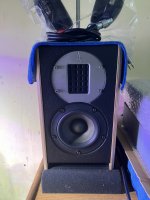SuzyJ = 'HiFi'Clinical is why I built it🩺😄
P3A = 'OkFi'
Speaking of heat, I'm just getting back to my 50w and 100w projects and looking for appropriate heatsinks now. Did you source them for your builds locally (in Australia) @cowanaudio? 🙂. The construction notes suggest a Conrad MF30 but curious as to what others may be using.Apart from heat, there's not much to gain.
Last edited:
Thanks, that's a much better idea actually! I have been looking at compact heatsink cases to use but they tend to be very expensive from China due to the shipping now. I guess that's just the way of the world now. Are there alternative sources or just aliexpress and ebay?2107 chassis readily available online.
Excellent! Great to know. 👍I'll try to mount a pair of the 100 watt boards in one with a connex psu... I was looking at speaker protection boards on AliExpress if I can find one that's known to be reliable and won't degrade the sound too much, or I could look to one of the many DIY audio projects for them if anyone can suggest a simple one? The pace I move though, a prebuilt board might be better 😆It's all an easy fit in that case.
Last edited:
Noticed that ST404 is available at Digikey so no need to hassle with futurlec.
https://www.digikey.se/en/products/detail/linear-integrated-systems-inc/SST404-SOIC-8L-TB/14312203
Digikey seems to have stocked up some dual Jfets recently, or is it just the Coronasqureeze that is gone?
https://www.digikey.se/en/products/detail/linear-integrated-systems-inc/SST404-SOIC-8L-TB/14312203
Digikey seems to have stocked up some dual Jfets recently, or is it just the Coronasqureeze that is gone?
Hello friends,
My first post in DIY forums after a year of scrolling
I have a plan for a small AB project to replace the cheap amplifier I have by the time I complete Alephj..( already purchased boards and fet )
I found that AEM fits my plan for a medium, power AB
I have a few doubts....can this be done on a +-24v rail ...then what is the power op...also in that case whats the trf va needed
also, I see "Wolverine" Power Amplifier which is always rated as no1 in class AB ratings....how does it compare to AEM6000
My first post in DIY forums after a year of scrolling
I have a plan for a small AB project to replace the cheap amplifier I have by the time I complete Alephj..( already purchased boards and fet )
I found that AEM fits my plan for a medium, power AB
I have a few doubts....can this be done on a +-24v rail ...then what is the power op...also in that case whats the trf va needed
also, I see "Wolverine" Power Amplifier which is always rated as no1 in class AB ratings....how does it compare to AEM6000
@giri0076 Do you mean 24V DC after rectification, going into the amp? You will need a bit more juice for a Mosfet amp I think. +/-36V DC is a good start to get to 50W.
The Wolverine uses BJTs, it would be difficult to compare to the AEM here which uses Lateral mosfets. What sound do you prefer? Mosfets have a reputation for a smoother warm but detailed sound, BJTs maybe a faster, punchy sound. You need an example of both. BJTs are easier to implement as a designer and much easier to source (and match) so are more prevalent in the industry.
Bare minimum transformer power I would say 150VA for a small bookshelf system, near field listening. I am using 160VA O-core 2 x 29V (or will be when it arrives). My speakers are diminutive Kensai 2's handmade by Simon from Audiosmile UK, bloody incredible things for their size.
While I'm here then, here is my AEM6000 build using Suzy's first version PCBs. It's a long story getting to this stage, I made some boards up, sold them, then made some more. I love SMD designs, these little amp boards are just great design by Suzy (then she publishes updates...)
Anyway, James transformers took ages to make a 160va O-core then it arrives with the secondary voltages all messed up, they screwed the puppy totally. Now they are on holiday and it might take a while yet.
Using Shaan's power supply PCB with protection built in, very tight in there. Neutrik Speakons and DIN connector for input, I'm done with RCA's, they are not designed for audio signals. Ultimately I will spray the case matt textured grey such as my headphone amp pictured.
If anyone is interested, I highly recommend this compact enclosure with these 60mm heatsinks for Suzy's 50W boards.
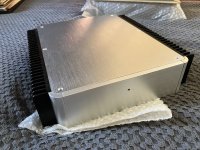
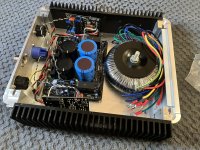
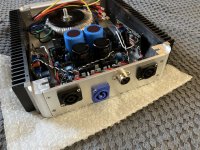
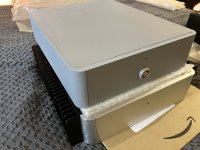
The Wolverine uses BJTs, it would be difficult to compare to the AEM here which uses Lateral mosfets. What sound do you prefer? Mosfets have a reputation for a smoother warm but detailed sound, BJTs maybe a faster, punchy sound. You need an example of both. BJTs are easier to implement as a designer and much easier to source (and match) so are more prevalent in the industry.
Bare minimum transformer power I would say 150VA for a small bookshelf system, near field listening. I am using 160VA O-core 2 x 29V (or will be when it arrives). My speakers are diminutive Kensai 2's handmade by Simon from Audiosmile UK, bloody incredible things for their size.
While I'm here then, here is my AEM6000 build using Suzy's first version PCBs. It's a long story getting to this stage, I made some boards up, sold them, then made some more. I love SMD designs, these little amp boards are just great design by Suzy (then she publishes updates...)
Anyway, James transformers took ages to make a 160va O-core then it arrives with the secondary voltages all messed up, they screwed the puppy totally. Now they are on holiday and it might take a while yet.
Using Shaan's power supply PCB with protection built in, very tight in there. Neutrik Speakons and DIN connector for input, I'm done with RCA's, they are not designed for audio signals. Ultimately I will spray the case matt textured grey such as my headphone amp pictured.
If anyone is interested, I highly recommend this compact enclosure with these 60mm heatsinks for Suzy's 50W boards.




Attachments
Last edited:
I built a +/-24V version that I used in my accommodation at work for a good few years. Performance was identical to the 50W version but at lower power. I reduced the input load resistors to 10K to ensure good bias for the next stage. I was able to get about 20W into 8 ohms. I used a 60VA transformer to run a pair.I have a few doubts....can this be done on a +-24v rail ...then what is the power op...also in that case whats the trf va needed
Hai Suzy ,, passive420,, Thanks for the reply,,,,
more questions
1) is it worth to do a dual mono setup for 100w version
2) in discrete space is there any medium power AB comparable to Suzys ...not chip amps
more questions
1) is it worth to do a dual mono setup for 100w version
2) in discrete space is there any medium power AB comparable to Suzys ...not chip amps
You need to provide context. One of my uses for my 50W amp is driving my Ariel 2 way speakers. For these there are four amps used, one each for tweeters and woofers on each side. At the moment they share a common power supply, but I have plans to build them into the back of the speaker cabinets, so then the two sides will have their own independent supplies.
One of the nice things about this amp is the high PSRR, this means that it's less fussy about what's happening on the power supply, which in turn means you can get away with a lot in the power supply before it becomes noticeable. Much of the lore around dual mono (and heroic supply filtering) comes from crude low open loop amplifiers that push all the power supply hum straight into the speakers.
I'm not really up on other designs - I'm sure thare are heaps of other amps that are better than mine, at least in some metrics.
One of the nice things about this amp is the high PSRR, this means that it's less fussy about what's happening on the power supply, which in turn means you can get away with a lot in the power supply before it becomes noticeable. Much of the lore around dual mono (and heroic supply filtering) comes from crude low open loop amplifiers that push all the power supply hum straight into the speakers.
I'm not really up on other designs - I'm sure thare are heaps of other amps that are better than mine, at least in some metrics.
Still a very good amplifier, in relation to math its a relative of Morpheus here https://www.diyaudio.com/community/threads/morpheus-ultra-low-thd.406485/
Its one of the group of amplifiers that featured a high gain input stage which was on separate rails or not, followed by a lower gain buffer stage that did the level shifting or not, then followed by the very high gain VAS stage. VAS gain is a function of VAS symmetry and output stage impedance.
Its one of the group of amplifiers that featured a high gain input stage which was on separate rails or not, followed by a lower gain buffer stage that did the level shifting or not, then followed by the very high gain VAS stage. VAS gain is a function of VAS symmetry and output stage impedance.
- Home
- Amplifiers
- Solid State
- AEM6000 Based 50W Amp
